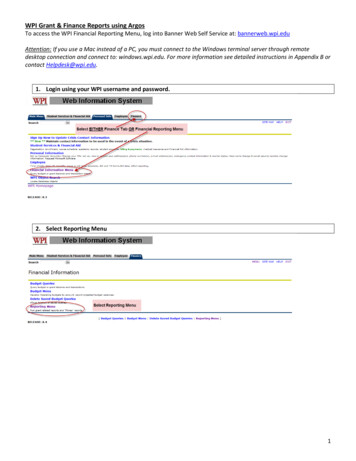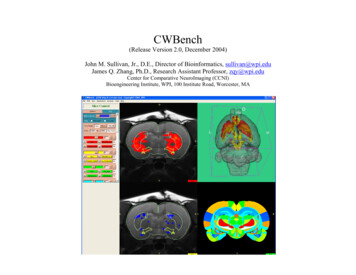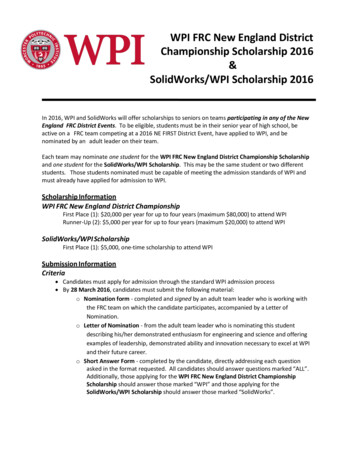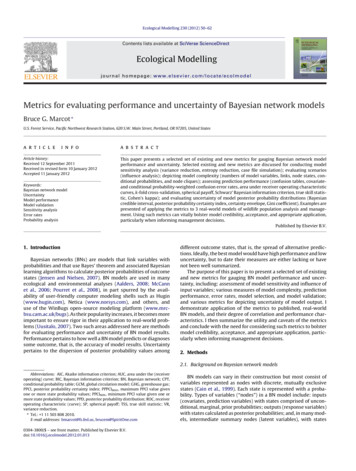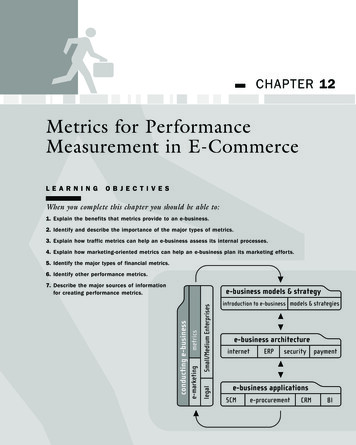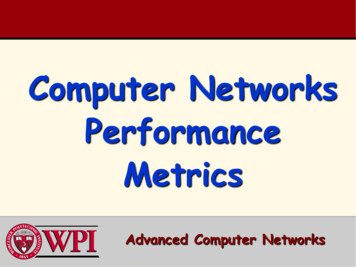
Transcription
Computer NetworksPerformanceMetricsAdvanced Computer Networks
Computer stGHostFAdvanced Computer NetworksPerformance Metrics2
Simple Queuing ModelCustomerArrivalsQueueAdvanced Computer NetworksServerPerformance Metrics3
Router Nodenode 15packetpacketIncoming LinkRouter BufferAdvanced Computer NetworksServer17Outgoing LinkPerformance Metrics4
Generic Performance MetricsUtilization ::– the percentage of time a device is busy servicinga “customer”.Throughput ::– the number of jobs processed by the “system”per unit time.Response time ::– the time required to receive a response to arequest (round-trip time).Delay ::– the time to traverse from one end to the otherof a system.Advanced Computer NetworksPerformance Metrics5
Network Performance Measures Channel utilization:: the averagefraction of time a channel is busy[e.g. Util 0.8]– when overhead is taken into account(i.e., excluded from useful bits), channelutilization is often referred to as channelefficiency. Throughput:: bits/sec.successfullysent[e.g. Tput 10 Mbps]Advanced Computer NetworksPerformance Metrics6
End-to-End Packet DelayEnd-to-end delay includes multiple hop link delays.TanenbaumAdvanced Computer NetworksPerformance Metrics7
Hop Delay ComponentsAdvanced Computer NetworksPerformance Metrics8
End-to-end Packet DelayEnd-to-end packet delay :: the time todeliver a packet from source todestination.{Most often, we are interested in thepacket delay within the communicationssubnet.} This delay is the sum of thedelays on each subnet link traversedby the packet.Each link delay consists of fourcomponents[B&G Bertsekas andGallager]:Advanced Computer NetworksPerformance Metrics9
Link Packet Delay1. The processing delay [PROC] betweenthe time the packet is correctlyreceived at the head node of theincoming link and the time the packet isassigned to an outgoing link queue fortransmission.2. The queuing delay [QD] between thetime the packet is assigned to a queuefor transmission and the time it startsbeing transmitted. During this time,the packet waits while other packets inthe transmission queue are transmitted.Advanced Computer NetworksPerformance Metrics10
Link Packet Delay3. The transmission delay [TRANS]between the times that the first andlast bits of the packet aretransmitted.4. The propagation delay [PROP] betweenthe time the last bit is transmitted atthe head node of the link queue andthe time the last bit is received atthe next router. This is proportionalto the physical distance betweentransmitter and receiver.Advanced Computer NetworksPerformance Metrics11
End-to-End Packet DelayLink packet delay PROC QD TRANS PROPend-to-end packet delay sum ofALL link packet delays.Be Careful !!end-to-end can be defined either:– from Host-to-Host– or only from end-to-end nodes withinthe subnetwork.Advanced Computer NetworksPerformance Metrics12
End-to-End Packet DelayEnd-to-end delay includes multiple hop link delays.TanenbaumAdvanced Computer NetworksPerformance Metrics13
Network Performance Measures Latency ::– usually implies the minimum possible delay. Latencyassumes no queuing and no contention encountered alongthe path. Goodput ::– {measured at the receiver} the rate in bits per secondof useful traffic received. Goodput excludes duplicatepackets and packets dropped along the path. Fairness ::– either Jain’s fairness or max-min fairness are used tomeasure fair treatment among competing flows. Quality of Service (QoS) ::– a QoS measure accounts for importance of specificmetric to one type of application [e.g. jitter andplayable frame rate for streaming media].Advanced Computer NetworksPerformance Metrics14
Wireless Performance MetricsWLANs and WSNs are concerned withpacket loss and employ additional metrics:Delivery ratio::– the ratio of packets received to packets sent{excluding duplicates and retransmissions}.Packet loss rate::– the percentage of packets lost or dropped.Link layer retransmission rates::– the percentage of DL layer frames that areretransmitted.Advanced Computer NetworksPerformance Metrics15
Performance Metrics Summary The three most general performancemeasures are : utilization, throughputand response time.In computer networks, end-to-enddelay is an important performancemetric.Queuing models are used to analyzeand estimate computer networkperformance.Advanced Computer NetworksPerformance Metrics16
Performance Metrics Summary Other useful metrics include: latency,goodput, fairness and QoS metricssuch as jitter or playable frame rate.In wireless networks, delivery ratio,packet loss rate and link layerretransmission rates are valuablenetwork measures.Advanced Computer NetworksPerformance Metrics17
Performance Metrics Summary The three most general performance measures are : utilization, throughput and response time. In computer networks, end-to-end delay is an important performance metric. Queuing models are used to analyze and estimate computer network performance. Advanced Computer Networks Performance Metrics 16
